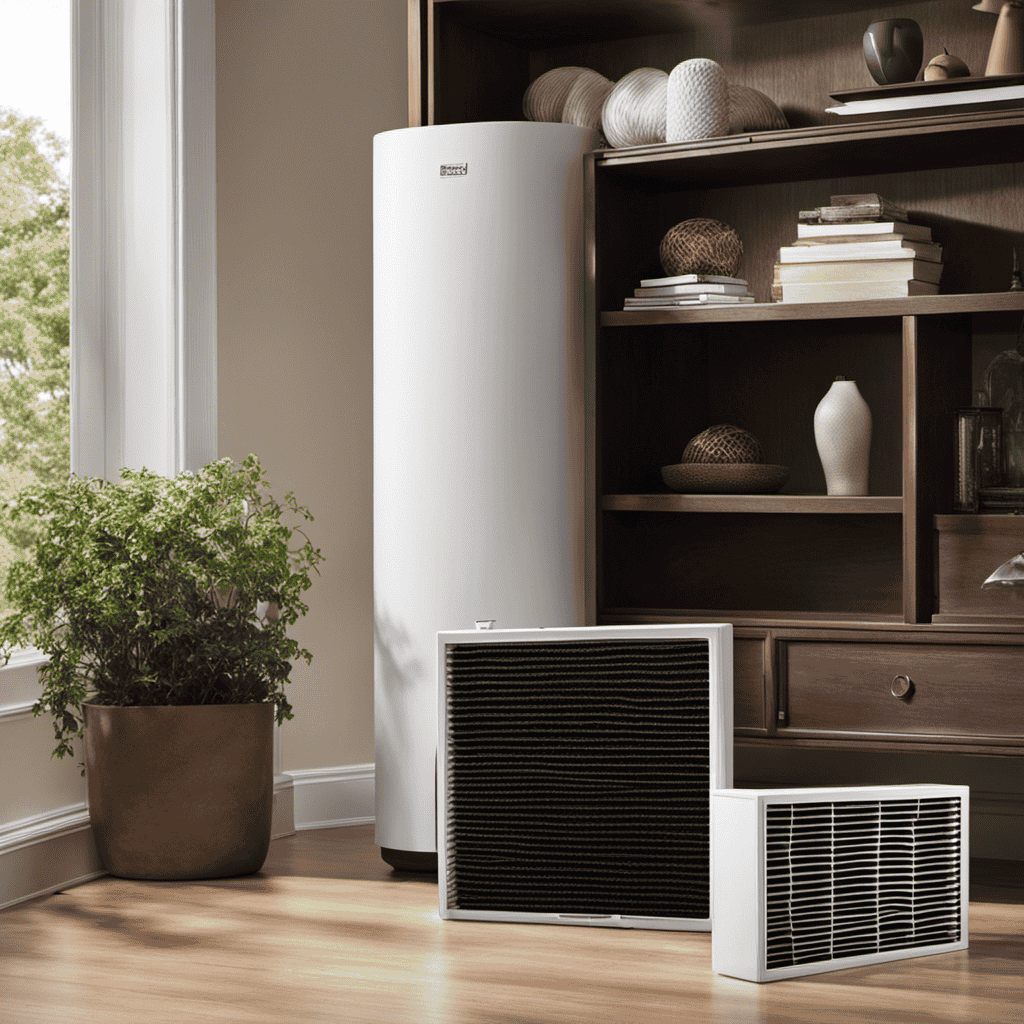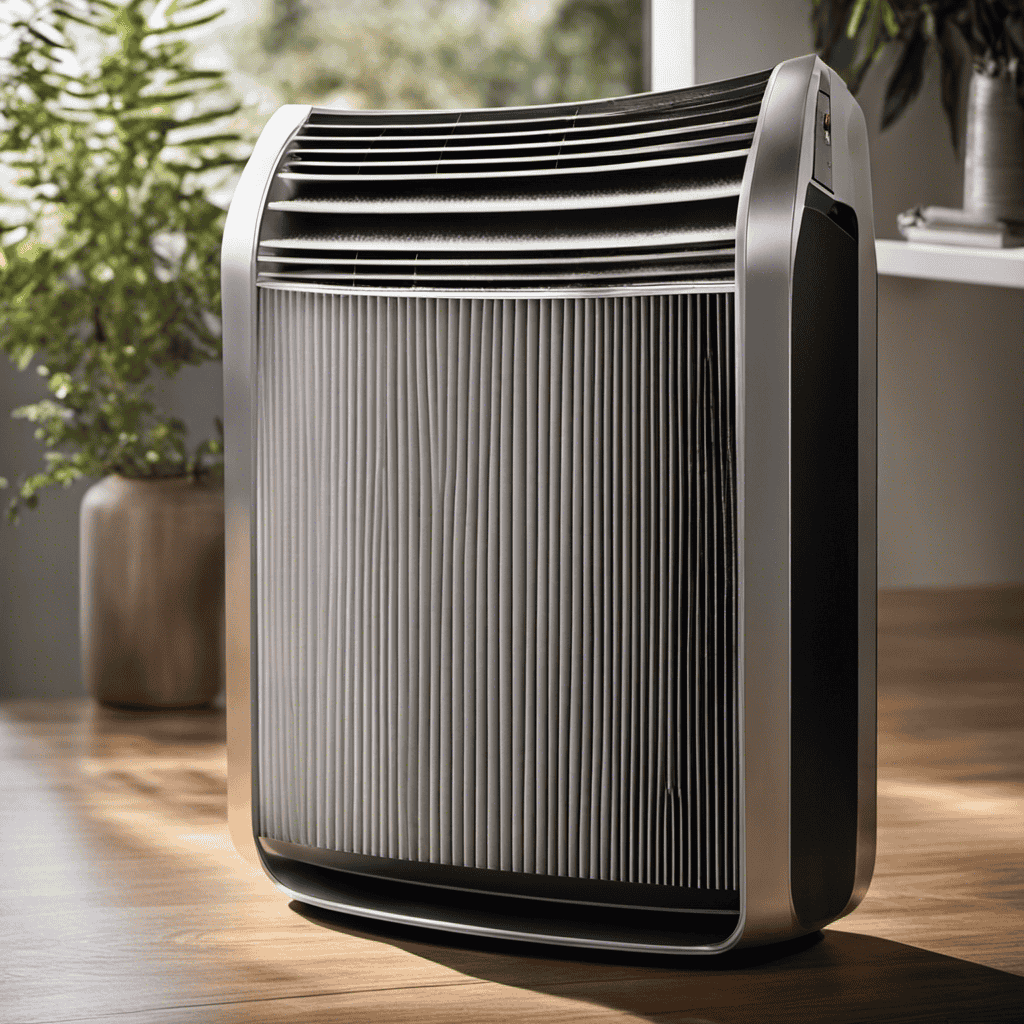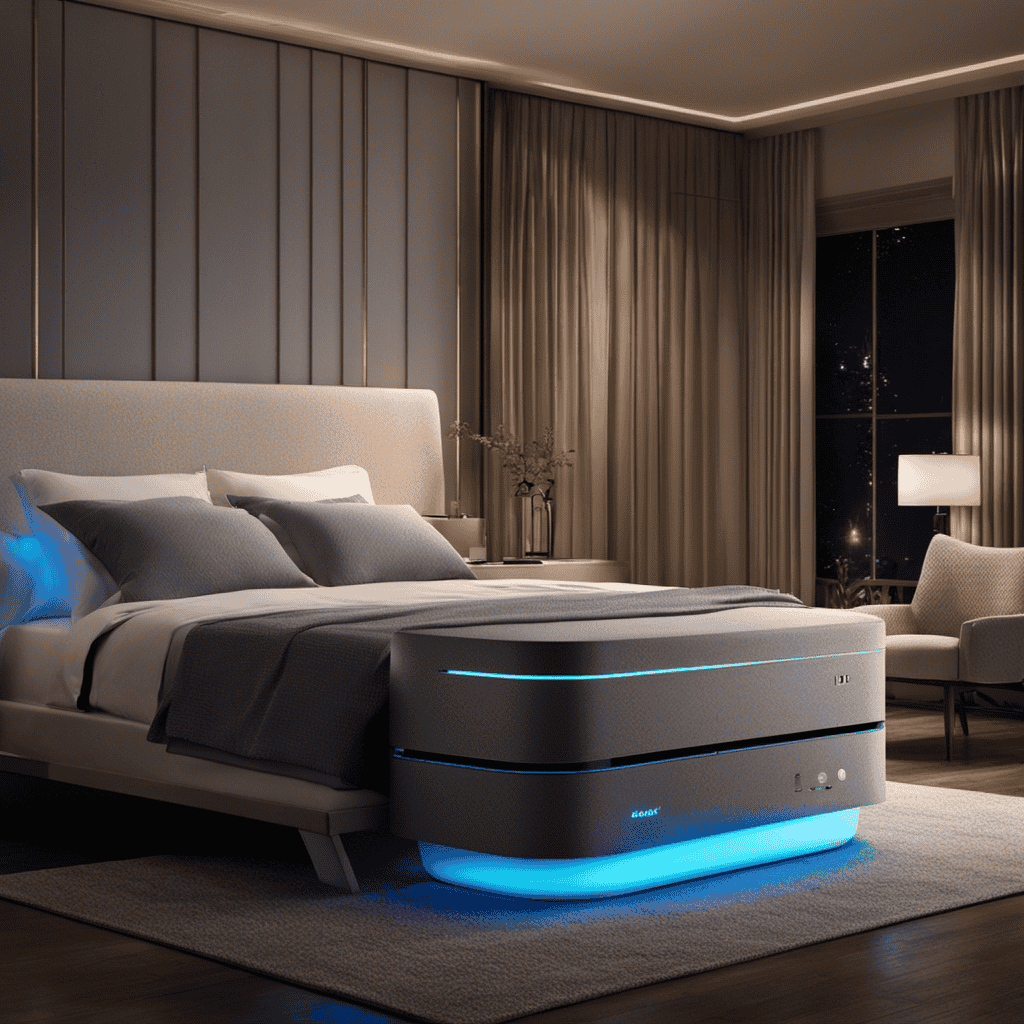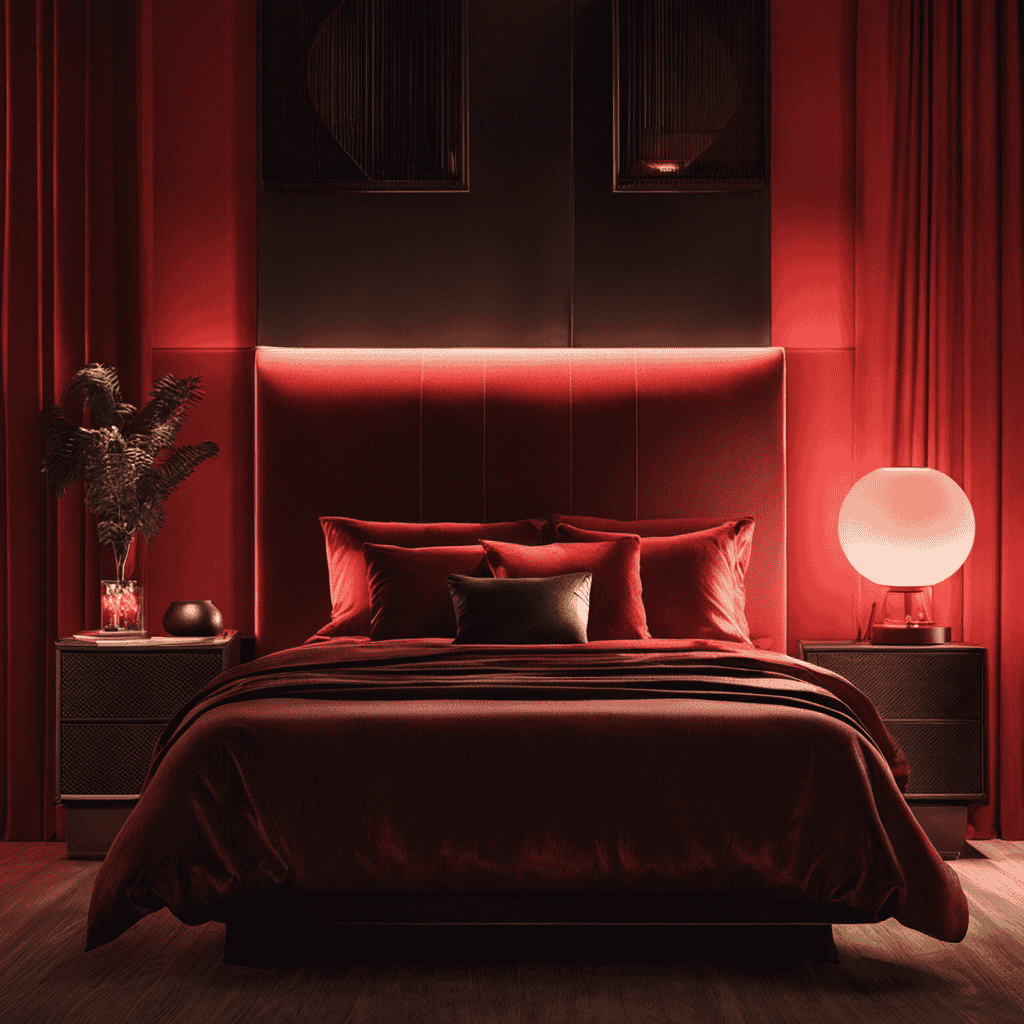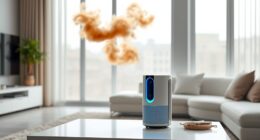As a owner of an air purifier, I frequently ask myself, ‘How frequently should I replace the filter in my air purifier?’ It’s a common inquiry that many of us have, and for valid reasons.
The filter in your air purifier plays a crucial role in maintaining clean and healthy indoor air. In this article, we will explore the importance of filter changes, factors to consider when determining the frequency, and signs that indicate it’s time for a replacement.
So, let’s dive in and uncover the secrets to keeping our air purifiers functioning at their best.
Key Takeaways
- Regularly changing the filter in your air purifier is crucial for maintaining clean and healthy indoor air.
- Factors such as high pollution levels, excessive pet dander, and heavily used air purifiers may require more frequent filter changes.
- Air quality plays a significant role in filter replacement, as exposure to air pollution can lead to respiratory problems and increase the risk of heart disease, stroke, and cancer.
- Following manufacturer recommendations for filter change frequency and properly maintaining the filters can maximize their lifespan and ensure optimal performance of the air purifier.
Understanding the Importance of Filter Changes
You should understand the importance of changing your air purifier’s filter regularly. Neglecting to change it can have a significant impact on the quality of the air in your home.
One of the key factors affecting filter efficiency is the type of pollutants present in your indoor environment. Different filters are designed to capture specific particles, such as dust, pollen, pet dander, or smoke. Over time, these particles can accumulate in the filter, reducing its ability to capture new pollutants. This accumulation can lead to decreased filter efficiency and compromised air quality.
Another factor to consider is the frequency of use. If you use your air purifier continuously or in a highly polluted environment, the filter will become clogged more quickly. This can result in reduced airflow and increased strain on the purifier’s motor, reducing its overall effectiveness.
Neglecting to change your air purifier’s filter regularly can have a significant impact on the air quality in your home. A clogged filter cannot effectively capture pollutants, allowing them to circulate in the air you breathe. This can lead to symptoms such as allergies, respiratory issues, and even worsen existing conditions like asthma.
Factors to Consider When Determining Filter Change Frequency
When determining how frequently to switch out the filter in your air purifier, there are several factors to consider. These factors can impact the filter change frequency and ultimately the air quality in your home or office. By understanding these factors, you can make informed decisions to ensure your air purifier is operating at its best.
One of the main factors to consider is the type of filter you are using. Different filters have different lifespans and effectiveness in capturing pollutants. HEPA filters, for example, are highly efficient at trapping particles as small as 0.3 microns, but they may need to be changed more frequently than other types of filters.
Another important consideration is the air quality in your environment. If you live in an area with high levels of pollution or have pets that shed a lot of dander, your filter may become clogged more quickly and require more frequent changes.
Table: Factors Affecting Filter Change Frequency
| Factor | Impact |
|---|---|
| Filter Type | Different filters have different lifespans and effectiveness in capturing pollutants. |
| Air Quality | High pollution levels or excessive pet dander can lead to more frequent filter changes. |
| Usage | A heavily used air purifier may require more frequent filter changes. |
| Manufacturer Recommendations | Follow the guidelines provided by the manufacturer for optimal filter change frequency. |
To ensure optimal air quality and performance of your air purifier, it is recommended to regularly monitor these factors and change the filter as needed. By doing so, you can enjoy cleaner and healthier air in your indoor environment.
The Role of Air Quality in Filter Replacement
When it comes to the lifespan of air filters, there are several factors to consider.
One of the most important factors is the impact of air pollution on the filter. Different levels of air pollution can affect the filter’s lifespan, and understanding these factors can help determine when it’s time for a replacement.
Impact of Air Pollution
If you live in an area with high levels of air pollution, it’s important to understand the impact it can have on your health. Air pollution effects can be detrimental, posing significant health risks. Here are four key points to consider:
-
Particulate Matter (PM): Air pollution often contains PM, which consists of tiny particles suspended in the air. These particles can enter your respiratory system and cause respiratory problems.
-
Chemical pollutants: Air pollution also contains harmful chemicals such as nitrogen dioxide and ozone. Exposure to these pollutants can lead to lung irritation, asthma, and other respiratory diseases.
-
Cardiovascular issues: Studies have shown that long-term exposure to air pollution can increase the risk of heart disease, stroke, and other cardiovascular problems.
-
Cancer risk: Certain air pollutants, such as benzene and formaldehyde, are known carcinogens. Prolonged exposure to these substances can increase the risk of developing cancer.
Understanding these health risks highlights the importance of having an effective air purifier with a well-maintained filter. Now let’s delve into the factors that affect filter lifespan.
Filter Lifespan Factors
To maximize the lifespan of your air purifier’s filter, regularly clean and maintain it according to the manufacturer’s instructions. Proper filter maintenance is essential for ensuring the effectiveness of your air purifier and extending its lifespan. There are several factors that can affect the lifespan of your air purifier’s filter, including the quality of the air in your environment, the frequency of use, and the type of filter you have. By understanding these factors and taking the necessary steps to maintain your filter, you can ensure that your air purifier continues to provide you with clean and healthy air for a longer period of time.
| Factors | Impact |
|---|---|
| Air Quality | Poor air quality can lead to a faster accumulation of pollutants on the filter, reducing its lifespan. |
| Frequency of Use | Regularly using your air purifier for extended periods of time can result in a shorter filter lifespan. |
| Filter Type | Different types of filters have different lifespans, with some requiring more frequent replacements than others. |
How Often Does the Manufacturer Recommend Changing the Filter
You should check the manufacturer’s recommendations for how often to change the filter in your air purifier. The manufacturer’s recommendations are based on various factors such as the type of filter, the air quality in your area, and the usage of the air purifier.
Here are some key points to consider:
-
Filter type: Different air purifiers use different types of filters, such as HEPA filters or activated carbon filters. The lifespan of these filters can vary.
-
Air quality: If you live in an area with high pollution or allergens, the filter may need to be replaced more frequently. The manufacturer’s recommendations will take this into account.
-
Usage: If you use your air purifier constantly or in a large space, the filter may accumulate more particles and require more frequent replacement.
-
Filter lifespan calculation: Manufacturers often provide an estimated lifespan for their filters. This is typically based on the average usage of the air purifier and the efficiency of the filter in capturing particles.
By following the manufacturer’s recommendations, you can ensure that your air purifier is functioning optimally and providing you with clean and healthy air.
Regularly changing the filter will help maintain the effectiveness of your air purifier and improve the air quality in your home or office.
Signs That Indicate It’s Time to Replace the Filter
In my research on how often to change the filter in an air purifier, I’ve come across some important signs that indicate it’s time for a replacement.
One of the most obvious signs is a visible accumulation of dirt and dust on the filter. Over time, the filter becomes clogged with these particles, reducing its effectiveness in capturing airborne pollutants.
Another sign is a decrease in the air purifier’s performance. If you notice that the air in your home doesn’t feel as fresh or clean as it used to, it could be a result of a dirty filter.
Additionally, an increase in allergy or asthma symptoms can be an indication that the filter needs to be changed. A dirty filter fails to remove allergens and irritants from the air, exacerbating respiratory issues.
Regularly changing the filter in your air purifier has several benefits. First and foremost, it improves the air quality in your home by effectively removing pollutants. A clean filter allows the air purifier to work optimally, ensuring that it can efficiently capture and trap contaminants.
This can lead to a reduction in allergy and asthma symptoms, as well as a healthier living environment. Moreover, a clean filter also helps prolong the lifespan of the air purifier itself, as it reduces strain on the motor and other components.
The Impact of Pet Hair and Dander on Filter Lifespan
Pet owners like myself often face the challenge of dealing with pet hair and dander accumulation in our homes. These pesky particles can wreak havoc on our air purifier filters, causing them to become clogged and less effective over time.
Understanding the impact of pet hair and dander on filter lifespan is crucial for maintaining clean and healthy indoor air quality.
Pet Hair Accumulation
The filter in your air purifier can become clogged with pet hair, so it’s important to change it regularly. Pet hair accumulation can significantly impact the effectiveness of your air purifier and compromise its ability to remove dander and other allergens from the air.
To ensure optimal performance and dander control, here are some cleaning techniques to keep in mind:
- Regularly vacuum and sweep your home to minimize loose pet hair.
- Groom your pets frequently to reduce shedding.
- Use a lint roller or tape to remove pet hair from furniture and other surfaces.
- Consider using a specialized pet hair attachment for your vacuum cleaner.
Dander and Clogged Filters?
To prevent dander from clogging the air purifier filter, it’s important to groom your pets frequently to reduce shedding. Dander, which consists of tiny skin particles and allergens, is a common cause of air purifier filter clogs. When dander accumulates on the filter, it restricts airflow, reducing the efficiency of the purifier and potentially impacting indoor air quality.
Research suggests that clogged filters can not only decrease the purifier’s ability to capture dander but also lead to the release of trapped particles back into the air. This can worsen allergies and respiratory issues for individuals sensitive to dander.
Regular grooming of your pets, such as brushing and bathing, helps to minimize dander production, preventing its accumulation and the subsequent negative effects on air purifier performance.
How Smoking Affects the Lifespan of Your Air Purifier Filter
If you smoke frequently near your air purifier, you’ll need to change the filter more often. Secondhand smoke can have a detrimental effect on the lifespan of your air purifier filter.
Here are the benefits of using an air purifier in a smoking household:
-
Improved indoor air quality: An air purifier can effectively filter out harmful pollutants and odors, including those from secondhand smoke. This helps to create a healthier and more comfortable living environment.
-
Reduced health risks: Secondhand smoke contains numerous toxic chemicals that can pose serious health risks, especially to children, pregnant women, and individuals with respiratory conditions. Using an air purifier can help to minimize exposure to these harmful substances.
-
Enhanced respiratory function: By removing smoke particles and irritants from the air, an air purifier can improve respiratory function and reduce symptoms such as coughing, wheezing, and shortness of breath.
-
Extended filter lifespan: Regular smoking near an air purifier can lead to a quicker accumulation of smoke particles and tar on the filter. Changing the filter more often can help to maintain the effectiveness of the air purifier and ensure optimal performance.
The Connection Between Filter Efficiency and Replacement Frequency
When it comes to air purifiers, finding the right balance between efficiency and longevity is crucial.
The efficiency of a filter refers to its ability to remove airborne particles, while longevity refers to how long the filter can effectively perform its job.
It is important to understand the connection between filter efficiency and replacement frequency in order to optimize the performance of your air purifier and maintain clean air in your space.
Efficiency Vs Longevity
You’ll want to consider the trade-off between efficiency and longevity when deciding how often to change the filter in your air purifier. Finding the right balance is crucial for effective filter maintenance and cost effectiveness.
Here are a few key points to keep in mind:
-
Efficiency: Regularly changing the filter ensures optimal air purification by removing contaminants and allergens effectively. A clean filter means better air quality and improved respiratory health.
-
Longevity: While frequent filter changes enhance efficiency, they can also increase the overall cost of maintenance. Extending the filter’s lifespan could save you money, but it may compromise the air purifier’s effectiveness over time.
-
Air quality: Regularly changing the filter guarantees continuous clean air flow, providing a healthier environment for you and your family.
-
Manufacturer’s recommendations: Always refer to the manufacturer’s guidelines for specific filter replacement intervals, as they may vary depending on the air purifier model and usage. Following these recommendations will help maintain the air purifier’s performance and prolong its lifespan.
Optimal Filter Replacement
To ensure optimal performance of your device, it’s important to adhere to the recommended intervals for replacing the air purifier’s filter. The filter replacement frequency varies depending on several factors, such as the manufacturer’s instructions, the type of air purifier, and the air quality in your environment. Generally, it is recommended to replace the filter every 6 to 12 months.
However, if you live in an area with high levels of pollution or if you have pets or allergies, it may be necessary to replace it more frequently. Extending the filter lifespan can be achieved by regularly cleaning the pre-filter and maintaining a clean environment. By vacuuming the pre-filter and removing any accumulated dust or debris, you can help prolong the effectiveness of the main filter.
Now, let’s explore whether regular maintenance can further prolong the life of the filter.
Can Regular Maintenance Prolong the Life of the Filter
Regular maintenance can significantly extend the lifespan of your air purifier’s filter. Taking care of your filter is crucial to ensure optimal performance and clean air in your home. Here are some essential filter maintenance tips to keep in mind:
-
Regularly check and clean the pre-filter: The pre-filter is the first line of defense against larger particles. Cleaning it every one to two weeks will prevent the main filter from clogging and maintain efficient air flow.
-
Follow the manufacturer’s guidelines: Different air purifiers have varying filter replacement schedules. Refer to the user manual or manufacturer’s instructions to determine how often you should change the filter.
-
Keep track of filter lifespan: Some air purifiers come with a filter replacement indicator. Pay attention to this indicator or set reminders to keep track of when it’s time to replace the filter.
-
Consider the air quality in your area: If you live in a highly polluted environment or have pets, you may need to change the filter more frequently to maintain optimal air quality.
Regularly maintaining and changing your air purifier’s filter has several benefits. It ensures that the filter is clean and able to capture airborne particles effectively, improving indoor air quality. Additionally, regular filter changes can prevent the accumulation of dust and allergens, reducing allergy symptoms and respiratory issues.
Transitioning into the subsequent section about ‘diy vs. professional filter replacement: which is better,’ it’s important to weigh the pros and cons of each option to determine the best approach for your specific needs and circumstances.
DIY Vs. Professional Filter Replacement: Which Is Better
In my previous subtopic, I discussed the importance of regular maintenance for prolonging the life of the filter in your air purifier. Now, let’s explore the options for filter replacement: DIY versus professional service.
Many people prefer to take the DIY route when it comes to filter cleaning and replacement. It can be a cost-effective solution and allows you to have more control over the process. However, there are some important considerations to keep in mind.
| DIY Filter Cleaning | Benefits of Professional Replacement |
|---|---|
| Requires time and effort | Expertise and knowledge |
| May not fully remove all contaminants | Ensures proper installation |
| Risk of damaging the filter | High-quality replacement filters |
| May void warranty | Improved air quality |
While DIY filter cleaning may seem like a convenient option, it is important to note that it may not effectively remove all contaminants, risking the air quality in your home. Additionally, improper cleaning techniques can damage the filter or even void its warranty.
On the other hand, professional filter replacement offers numerous benefits. Experts have the knowledge and expertise to ensure proper installation, guaranteeing optimal performance. Moreover, professional services provide high-quality replacement filters, further improving the air quality in your space.
Ultimately, the choice between DIY and professional filter replacement depends on your preferences and the specific requirements of your air purifier. However, considering the benefits of professional replacement, it is worth considering to ensure the longevity and effectiveness of your air purifier.
The Role of Environmental Factors in Filter Replacement
One important factor to consider when replacing filters is how environmental conditions can impact their effectiveness. The role of temperature and humidity in filter replacement cannot be understated. Here are four key points to keep in mind:
-
Temperature: Extreme temperatures can affect the performance of air purifier filters. High temperatures can cause filter materials to break down, reducing filtration efficiency. On the other hand, low temperatures can cause filters to become less flexible, reducing their ability to capture airborne particles effectively.
-
Humidity: Excessive humidity can promote the growth of mold and bacteria, which can compromise the effectiveness of filters. It is important to maintain proper humidity levels in your home to ensure optimal filter performance.
-
Air pollutants: The presence of air pollutants such as dust, pollen, pet dander, and smoke can significantly impact the efficiency of filters. Filters can become clogged and saturated with these particles, reducing their ability to effectively capture contaminants.
-
Filter lifespan: The combination of temperature, humidity, and air pollutants can shorten the lifespan of filters. Regularly monitoring filter condition and replacing them as needed is crucial to maintaining clean and healthy indoor air quality.
Understanding the role of temperature, humidity, and air pollutants in filter replacement is essential for ensuring the long-term effectiveness of your air purifier.
Now, let’s discuss how to properly dispose of used air purifier filters.
How to Properly Dispose of Used Air Purifier Filters
To ensure proper disposal of used air purifier filters, you can follow these guidelines.
Proper disposal methods for air purifier filters are essential to minimize environmental impact and ensure the protection of human health.
When it comes to disposing of used filters, recycling options are available. Many air purifier manufacturers have specific recycling programs for their filters. These programs allow you to send back used filters to the manufacturer, who will then recycle them appropriately.
Additionally, some local waste management facilities or recycling centers may accept used air purifier filters for recycling. It’s important to check with your local authorities to determine if this option is available in your area.
Recycling air purifier filters not only reduces waste but also helps recover valuable materials such as plastic and metal, which can be reused in various industries.
Frequently Asked Questions About Filter Replacement in Air Purifiers
FAQs about replacing filters in air purifiers typically include questions about how often filters need to be changed, where to buy replacement filters, and how to install them correctly. Maintaining clean air filters is essential for the efficient operation of an air purifier and ensuring the delivery of clean, healthy air.
Here are some important air purifier maintenance tips to keep in mind:
-
Regularly check the filter indicator: Most air purifiers have a filter indicator that alerts you when it’s time to replace the filter. Pay attention to this indicator and replace the filter accordingly.
-
Follow manufacturer’s recommendations: Each air purifier model may have specific recommendations for filter replacement. Consult the user manual or manufacturer’s website for guidance on how often to change the filters.
-
Purchase genuine replacement filters: To ensure optimal performance and compatibility, it’s recommended to buy replacement filters from the manufacturer or authorized retailers.
-
Properly install the filters: Incorrect installation can lead to reduced efficiency and compromised air quality. Follow the manufacturer’s instructions carefully to correctly install the filters.
Regularly replacing air purifier filters offers several benefits, including improved air quality, reduced allergens, and increased lifespan of the air purifier itself. By following these maintenance tips, you can maximize the effectiveness of your air purifier and enjoy clean, fresh air in your home or office.
Frequently Asked Questions
What Are the Potential Health Risks of Not Changing the Air Purifier Filter Regularly?
Not changing the air purifier filter regularly can pose potential health risks. The filter’s primary function is to capture and remove airborne pollutants, such as dust, pollen, and bacteria. When the filter becomes clogged and dirty, its efficiency decreases, allowing these harmful particles to circulate in the air.
This can lead to various health issues, including allergies, respiratory problems, and increased susceptibility to infections. Therefore, regular filter changes are of utmost importance to maintain the air quality and safeguard your health.
Can I Clean and Reuse the Air Purifier Filter Instead of Replacing It?
I often wonder if I can clean and reuse the air purifier filter instead of replacing it. While it may seem like a cost-saving option, it is generally not recommended.
Cleaning may not restore the filter to its full cleaning efficiency, and reusing it can drastically reduce its lifespan. It’s best to follow the manufacturer’s recommendations and replace the filter regularly to ensure optimal air purification and maintain a healthy indoor environment.
How Does the Size of the Room or Area Being Purified Affect the Frequency of Filter Changes?
The frequency of filter changes for an air purifier can be influenced by the size of the room or area being purified.
Larger spaces may require more frequent filter changes due to higher levels of pollutants and particles in the air.
It is important to consider the recommended filter replacement schedule provided by the manufacturer, as well as monitoring the air quality in your specific room to determine when a filter change is necessary.
Are There Any Specific Filters That Are Better Suited for Removing Pet Hair and Dander?
When it comes to removing pet hair and dander, it’s important to choose the right filter for your air purifier. The best air purifier filters for this purpose are usually HEPA filters. HEPA filters are designed to effectively capture small particles like pet allergens. These filters have a high efficiency rate and can significantly improve indoor air quality for those with pet allergies.
To ensure optimal performance, it’s recommended to replace the filter according to the manufacturer’s instructions.
Can I Use a Generic or Off-Brand Filter Instead of the Manufacturer-Recommended Filter for My Air Purifier?
I’ve recently been researching air purifiers, and one question that came up was whether it’s okay to use a generic or off-brand filter instead of the manufacturer-recommended one.
Well, let me tell you, there are some advantages to using the recommended filter. Firstly, it ensures optimal performance and efficiency of your air purifier.
Additionally, using a generic filter may not provide the same level of filtration, potentially allowing harmful particles to circulate in your home.
Is Changing the Air Purifier Filter the Same as Cleaning It?
Yes, changing the air purifier filter is not the same as cleaning it. It is important to clean air purifier filter regularly to maintain its efficiency and prolong its lifespan. Regular cleaning ensures that the filter is free from dust and other particles, allowing it to effectively purify the air.
Conclusion
In conclusion, it is crucial to keep the filter in your air purifier clean and fresh for maintaining a healthy indoor environment. By regularly changing the filter, you can ensure that your air purifier continues to effectively remove pollutants and allergens from the air.
Remember, just like changing the oil in your car or replacing the batteries in your smoke detector, filter replacement is an essential task that should not be overlooked.
So, don’t let your air purifier filter become the forgotten hero of your home. Give it the attention it deserves and breathe easy knowing that you’re taking proactive steps towards cleaner air.
